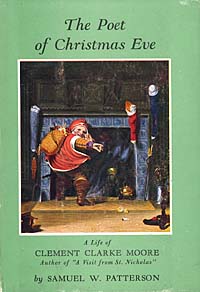In order to pursue that idea we must first take a look at one of Moore's inventions, the
names of the eight reindeer:
"Now, Dasher! Now, Dancer! Now Prancer and Vixen! On, Comet! On, Cupid! On, Donder and
Blitzen!"
This intricate little group includes two instances of alliteration (Dasher/Dancer and Comet/Cupid),
as well as an internal rhyme (Dancer/Prancer). The entire poem is beautifully structured, hardly a jingle dashed
off in a few moments, and the rhyme is perfect throughout except for the names of the two reindeer,
Vixen and Blitzen. It certainly seems curious that at the one place in the poem where Moore could
have used any two rhyming words, he would fail to produce a matched pair. It must be wondered
whether one of these names might originally have been something else, and if so, when it might have been changed.
In response to the second part of the question, we must take note of the fact that the earliest
version we have of the poem is at fourth hand: the printed version in the Troy Sentinel of
December 23, 1823. The first version of course was the original composition, from which a copy
was made by an unnamed relative of Moore, and then from that copy Harriet Butler made another copy
[Christop does not seem to know that Harriet Butler WAS a cousin of
Moore's] which her father (the Rev. David Butler) showed to editor Orville L. Holley, who
in turn would have given it to a typesetter. Thus there were at least four persons who could
have altered the poem between its creation and its publication. At any point in the several
recopyings, the poem may have been altered in such a way that a false rhyme was created.
Our next task is to see if one of the two names seems in any way inappropriate, and in fact, it is
the word Blitzen that is not quite right in the scheme of things. Not only does it fail to rhyme,
but it is a German word paired with a Dutch word, Donder. Modern versions often correct the
odd pair to become the German Donner and Blitzen, but we might consider the Dutch equivalent:
Donder and Blixsem.
This does not solve our dilemma, since Bliksem is also not a true rhyme for Vixen. Thus, since the rest of the poem
does not exhibit false rhyme, the possibility must be considered that what Moore originally
wrote was Bliksen.
In medieval Dutch the word had been, in fact, Blixene, but by the time Moore was writing his
poem, Bliksem had been in use for centuries. We must concede one of two possibiilites:
either Bliksen was a dialect form in use in the Hudson Valley, or else Moore misunderstood the word when he
heard it spoken. In fact, we have just such an expression used earlier upriver. Dr. Alexander
Coventry of Claverack wrote in his diary on June 13, 1786, that Derrick Van de Car "is
inclined to embellish his sentences with a strong exclamation in Dutch or English," and one
example Coventry cites is "dunder and blixen."3 Since the model for Moore's St. Nicholas was a
neighborhood Dutchman, Moore may well have heard isolated Dutch expressions being used
within shouting distance of his house.
Whether blixen is dialect or simply a misunderstanding, its use would have been an embarrassment
to the specialist in language and literature, reason enough for Moore to avoid being
identified as the author of "'Twas the night before Christmas." However, the only evidence to support
our theory is the curiously unnecessary false rhyme and the unlikely mixture of Dutch thunder
with German lightning.
After all this is said and done, we must recognize that more important than how the reindeer
were named or from whence the description of St. Nicholas was derived is the fact that Moore's
creation was the basis from which Santa Claus evolved. The Dutch Sinterklaas had not captured
the American imagination, but Moore's droll character immediately filled a mythic need of the American people.
It is ironic that the poem he tried at first to disavow, and only gradually came to appreciate, has made
Clement C. Moore one of our best loved writers, while those of his works which gave him his greatest
satisfaction have been almost forgotten.
****************************
1 The statemen is attributed to Moore in Samuel White Patterson's The Poet of Christmas Eve, p. 11.
2 Ibid., p. 16.
3 The present location of the original diaries is unknown. The New York State Library has a
manuscript made in 1889. Of course, we have no guarantee that Dr. Coventry
s hearing was more reliable than Professor Moore's (we would expect the conjunction between two
Dutch words to be en, not and)
****************************
Peter Christoph, a Fellow of the Society, is associated with the New York State Library in Albany.
